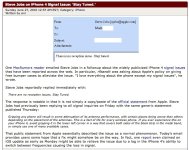Don't hold iPhone 4 that way, Apple says
'Avoid gripping it in the lower left corner in a way that covers both sides of the black strip in the metal band,' Apple says. Users have found that cradling the iPhone in their hand can cause loss of signal.
June 26, 2010|By David Sarno and Mark Milian, Los Angeles Times
A day after users discovered that cradling Apple Inc.'s new iPhone in your hand may interfere with its antenna and cause it to lose its signal, the company has suggested a solution:
Don't hold it that way.
Apple said that some loss of signal from gripping a handset is "a fact of life for every wireless phone," and that if it happens on the new iPhone, users should "avoid gripping it in the lower left corner in a way that covers both sides of the black strip in the metal band."
Or if you prefer, the company suggested, "simply use one of many available cases."
Apple redesigned the phone so the steel frame around the handset doubles as its antenna. The left side of the frame is used to broadcast a cellular signal; the right side is for other bands, such as Wi-Fi and Bluetooth.
As a result, people who tend to hold their phone in the left hand may be plagued by the signal problems more than those who hold the phone in their right hand.
Though Apple says every mobile phone has similar issues, it's not a phenomenon the gadget experts at ISuppli Corp. have seen before. That's because nearly all smart phones — including earlier iPhone models — have the cell antenna packaged inside the case, along with the circuitry.
But Apple's plan for wrapping the antenna around the phone was to boost its cellular performance, according to comments from Chief Executive Steve Jobs at the phone's unveiling this month.
Gripping the lower part of the phone may interfere with a piece called a radio frequency ground plane, which helps amplify the phone's cell connection. That piece, said ISuppli hardware analyst Kevin Keller, is susceptible to electrical currents — even those from contact with human skin.
Some bloggers quickly ridiculed Apple's response by assembling dozens of images from Apple promotional materials showing actors holding the phone in a way that appeared to be different from what Apple now recommends.
"Apple, you're holding it wrong," read a caption for an image that a blogger posted Friday.
'Avoid gripping it in the lower left corner in a way that covers both sides of the black strip in the metal band,' Apple says. Users have found that cradling the iPhone in their hand can cause loss of signal.
June 26, 2010|By David Sarno and Mark Milian, Los Angeles Times
A day after users discovered that cradling Apple Inc.'s new iPhone in your hand may interfere with its antenna and cause it to lose its signal, the company has suggested a solution:
Don't hold it that way.
Apple said that some loss of signal from gripping a handset is "a fact of life for every wireless phone," and that if it happens on the new iPhone, users should "avoid gripping it in the lower left corner in a way that covers both sides of the black strip in the metal band."
Or if you prefer, the company suggested, "simply use one of many available cases."
Apple redesigned the phone so the steel frame around the handset doubles as its antenna. The left side of the frame is used to broadcast a cellular signal; the right side is for other bands, such as Wi-Fi and Bluetooth.
As a result, people who tend to hold their phone in the left hand may be plagued by the signal problems more than those who hold the phone in their right hand.
Though Apple says every mobile phone has similar issues, it's not a phenomenon the gadget experts at ISuppli Corp. have seen before. That's because nearly all smart phones — including earlier iPhone models — have the cell antenna packaged inside the case, along with the circuitry.
But Apple's plan for wrapping the antenna around the phone was to boost its cellular performance, according to comments from Chief Executive Steve Jobs at the phone's unveiling this month.
Gripping the lower part of the phone may interfere with a piece called a radio frequency ground plane, which helps amplify the phone's cell connection. That piece, said ISuppli hardware analyst Kevin Keller, is susceptible to electrical currents — even those from contact with human skin.
Some bloggers quickly ridiculed Apple's response by assembling dozens of images from Apple promotional materials showing actors holding the phone in a way that appeared to be different from what Apple now recommends.
"Apple, you're holding it wrong," read a caption for an image that a blogger posted Friday.









